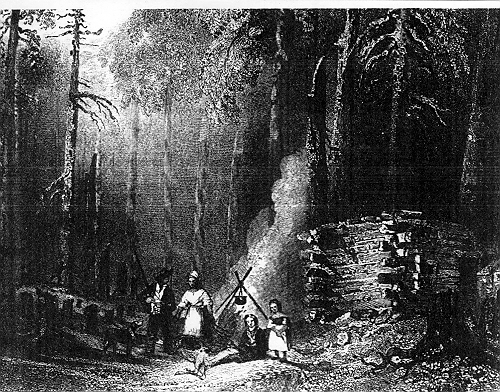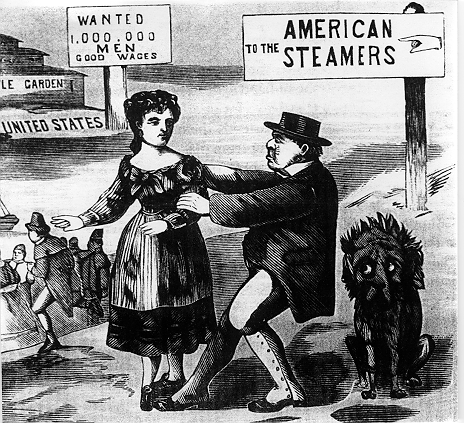


This posting is a copy of an original advertisement for the sale of
the land to Nicholas Devereux or Asher Tyler from the Holland
Land Company (May, 1837)

This picture gives one an idea of what it may have looked like to the earliest settlers in New
Ireland (circa 1845)

This editorial cartoon depicts the lure of jobs in America to the Irish around the the
1840's.
As the immigrants of this period poured into our nation they brought with them the hopes and dreams of a "new life". Scarred by political persecution,natural disasters such as the Potato Famine,religious discrimination,poverty and other personal tragedies these prospective "new Americans" sought a better place to raise their families. Optimism, fueled by stories of freedom and opportunity helped to overcome feelings of anguish and loss as their ships sailed farther and farther from the "Old Country". What most of these voyagers did not forsee was the sweatshops with their starvation wages,tenement life that would foster the spread of desease as entire families lived in one room without running water or lavatory facilities, or the cruel nativist backlash that would attempt to deprive them of any equality or political voice for as long as possible. Yet they survived! Most rose to these challenges and overcame the new roadblocks that stood in their way. This is our attempt to look at a small group of just such immigrants who would settle in a rural section of Western New York State around the year 1850. We hope to gather enough information on these settlers to compile an accurate record of their triumphs and tragedies.
Matthew Carey-journalist,author economic theorist emigratedto the U.S. from Ireland in 1784. He wrote of the need of the poor Irish to emigrate in July of 1828.----"Numerous instances are to be found throughout this country of Irish laborers on canals, who landed 2 or 3 years since in extreme poverty, and are now comfortably settled in small houses of their own."
Shamrock Freindly Association--New York City--July 1816
"It is invariably the practice of the American, and well suited to his love of independence, to purchase a piece of land as soon as he can afford it and cultivate his own farm, rather than live at wages. It is equally in the power of an emigrant to do the same after a few years of labor and economy."
We have found that Irish immigration to the U.S. can be traced back to the 18th Century and that the predominance of these early arrivals were from the North of Ireland,were mostly Protestant,settled in the south and had names like Jackson ,Crockett,etc. They fit in with the existing Anglo-American society quite easily. However by the mid 1800's Ireland was confronted with a growing number of tenant evictions for non-payment of rent to their British landlords and the terrible potato blight that struck the island from 1846 to 1851. As most of the Irish lived as subsistance farmers with potatoes being the crop of survival, this would become a disaster of monumental proportions. It has been recorded that approximately 1/3 of the population of Ireland either died from starvation or were forced to emigrate(1,000,000 deaths;2,000,000 emigrants). This created a new wave of Irish immigration to the U.S. in larger numbers than ever seen before. This population would be quite different than those that preceded it. This group would be Catholic and for the most part,a population that was economically destitute. They would coincidentely arrive in the U.S. when our country was undergoing drastic change itself. The Industrial Revolution was just beginning and our policy of Manifest Destiny encouraged expansion west. This new immigrant populus would provide a cheap labor force for northern manufacturing and serve the same purpose for creation of canals and later railroads.
Though the Irish immigrants contributed greatly in aiding the expansion of Industrialization and exploration of the western territory, they were often treated poorly by many Americans.
The new wave of immigrants meant fewer jobs for the American workers. Since these "new comers" were usually poor and needed jobs, employers would hire them to work for less money, to replace laborers who earned more. Not all aliens could fluently speak English, limiting their ability to acquire jobs. Many times when an immigrant tried to get work, the employer was unknowing of the fact that he was actually applying for a position, because they were unable to communicate. This discouraged foreigners, and made assimilation to American culture more difficult. It was for this reason why the Intelligence Office and Labor Exchange was developed. This organization provided them with medical attention, jobs, and the ability to obtain information. The new Americans also received other necessities, such as free lodging and meals through this group.
Fenianism played a major role in the Irish's outlook on life in the United States. A Fenian was described as a dreamer, an enthusiast, or a poet. The Irish, because they missed their homeland, often had Fenian beliefs. They dream of what they could be doing for the "Old Country", rather than find a career in America. It is usually when the Irish are poor, when they wish to return to their native land. However, when they became financially able to return home, they had already developed close ties to America, and decided to stay. Boston was predominantly Irish during the mid-to late 1800's. Many moved there because they were unable to buy farmland, and wanted to stay together. As a result, the Irish established successful schools. One of the only flaws to this achievement was that this slowed the assimilation process.
To be continued-